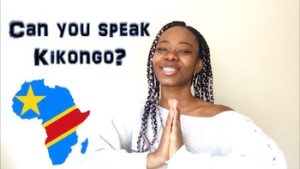
*The Kikongo language is celebrated on this date in 1500. It is one of the Bantu languages that the Kongo people speak in the Democratic Republic of the Congo, the Republic of the Congo, Angola, and Gabon.
Often called Kongo, it is a tonal language. It was spoken by many who were enslaved people during the Middle Passage. For this reason, while Kongo is still spoken in the countries mentioned above, creolized forms of the language are found in the ritual speech of Black religions, especially in Brazil, Cuba, Puerto Rico, the Dominican Republic, and Haiti. It is also one of the sources of the Gullah language and the Palenquero Creole in Colombia. Most present-day speakers live in Africa.
There are roughly seven million native speakers of Kongo, with perhaps two million more who use it as a second language. Kongo was the language of the Kingdom of Kongo before the Berlin Conference that balkanized the rest of the kingdom into three territories: parts of the DRC (Kongo Central and Bandundu), the Republic of the Congo, and Gabon. Kikongo is the base for the Creole language Kituba, also called Kikongo de l'État and Kikongo ya Leta (French and Kituba, respectively, for "Kikongo of the state administration" or "Kikongo of the State").
The constitution of the Congo uses the name Kituba, and the Democratic Republic of the Congo uses the term Kikongo. In contrast, Kituba is used in the administration. Kikongo has no standard orthography, with various uses in written literature, mostly newspapers, pamphlets, and a few books. Kongo was the earliest Bantu language that was committed to writing in Latin characters and had the earliest dictionary of any Bantu language. A catechism was produced under the authority of Diogo Gomes, a Jesuit born in Kongo to Portuguese parents in 1557, but no version of it exists today.
In 1624, Mateus Cardoso, another Portuguese Jesuit, edited and published a Kongo translation of the Portuguese catechism of Marcos Jorge. The preface informs us that the translation was done by Kongo teachers from São Salvador (modern Mbanza Kongo) and was probably partially the work of Félix do Espírito Santo (also a Kongo). A dictionary was written in about 1648 for the use of Capuchin missionaries, and the principal author was Manuel Robredo, a secular priest from Kongo (who became a Capuchin as Francisco de São Salvador). A sermon of two pages written only in Kongo is found in the back of this dictionary. The dictionary has some 10,000 words.
French missionaries created other dictionaries for the Loango Coast in the 1780s, and Bernardo da Canecattim published a word list in 1805. Baptist missionaries who arrived in Kongo in 1879 developed a modern language orthography. W. Holman Bentley's Dictionary and Grammar of the Kongo Language was published in 1887. In the preface, Bentley credited Nlemvo, an African, for his assistance. He described "the methods he used to compile the dictionary, which included sorting and correcting 25,000 slips of paper containing words and their definitions." Eventually, W. Holman Bentley, with João Lemvo, produced a complete Christian Bible in 1905. The Office of the High Commissioner for Human Rights has published a translation of the Universal Declaration of Human Rights in Fiote.